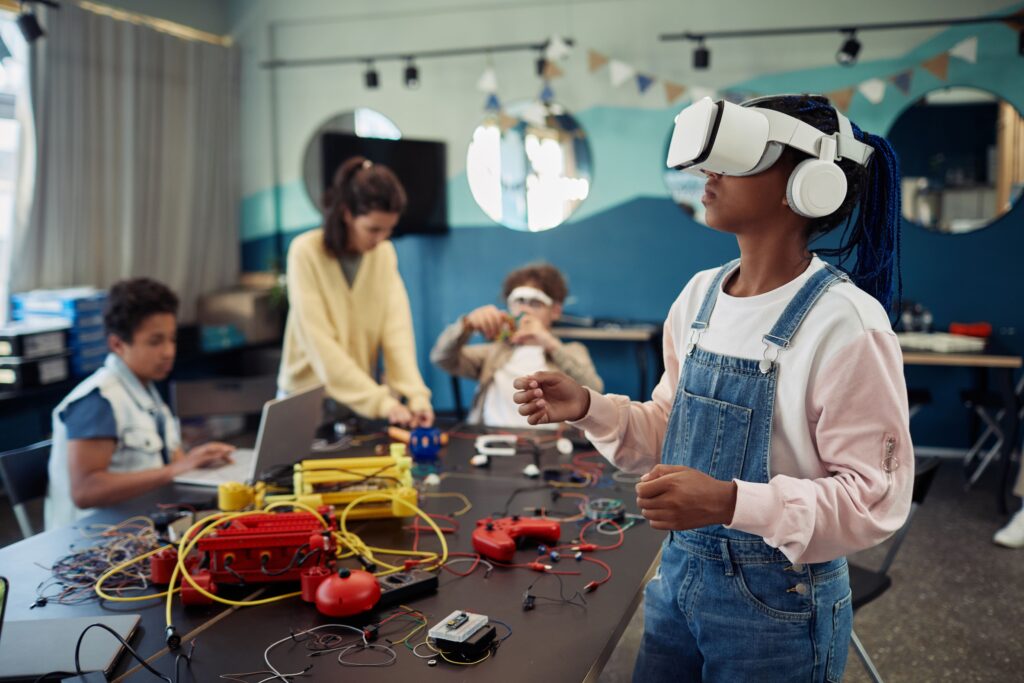VR Games: a new frontier in environmental education
As this is being written, 1,332,471,719 tons of waste are being thrown away. This is unfathomable for many of us. It is necessary for us all to understand the impact our actions have on the environment. But how can we raise awareness in an effective and engaging way?
Raising awareness with innovative games
For people to invest in sustainable development, their empathy must be awakened. The best way to achieve this is by immersing people in an environment that demonstrates how the accumulation of waste is affecting our planet.
Fortunately, nowadays, we have technology that allows us to perceive realities we are not used to seeing. This tool is virtual reality (VR). This immersive technology allows people to fully immerse themselves in a virtual universe, an environment lacking distractions from the real world.
Within the framework of sustainable development, virtual reality enables people to see futuristic landscapes and environments: illustrating what the world may look like if we do not fight climate change.
Because of its immersive quality, VR has huge potential to develop empathy and awareness in users. It is thus a key tool for raising sustainability awareness. This may be particularly effective for younger generations who will have the power to change tomorrow’s world and protect our planet.
The Syndicate for Innovation, Recycling and Energy through Waste and Household Waste (based in the French region Île-de-France) understood this perfectly. They called upon Mantu brand Novelab to develop a waste sorting project for middle school students.
Novelab created an interactive, collaborative, and multiplayer game to raise awareness about the life cycle of waste and the impact of humans on the environment. This VR game was produced with a young audience in mind and is playful and educational.

The game presents a point in the future when Earth has become uninhabitable. In this hypothesized version of the future, humans now reside on a new planet: one which has also become polluted with waste. As the new planet becomes uninhabitable, instead of resigning themselves to moving to another planet again and repeating the cycle, a group of young people decides to take charge by cleaning up and recycling the accumulated waste.
In the game, players must collect waste, sort it, and recycle it when appropriate. They also need to isolate ‘dangerous’ and explosive waste by bringing it to a hazardous waste disposal pit. The game involves teamwork: each student has a key role to play, and their actions impact how other players perform their tasks. All tasks are carried out virtually, with VR tech allowing users the possibility to move around the planet.
The project presents students with the reality of how waste affects our environment. It not only shows the life cycle of waste; the game also demonstrates how to effectively reduce its negative impact and even create a positive impact by re-using energy and materials.
Novelab created a technological suitcase, allowing total immersion in the game’s universe, thanks to virtual reality.
Making a positive impact: technology’s ambition
Used for the common good, VR can make a difference.
VR increases the rate of memorization because it allows the brain to create associations between the subject and the environment in which they are located. The way that VR engages the body promotes the retention of information and the involvement of the user in the experience.
Amaury La Burthe, CEO and Creative Director of Novelab
The use of this technology goes beyond its leisure and commercial properties. Indeed, VR can be used for social, environmental, as well as educational purposes, as explained in our article Why learning is better with VR.
In a global context, both virtual reality and augmented reality have been put at the service of the environment. For example, the UN Environment Program collaborated with Sony PlayStation to develop a virtual universe that embodies our carbon footprint in a sphere of color. As users virtually experience scenes from daily life, such as eating breakfast, they see their carbon footprint grow as an 18-meter-high colorful ball of gas.
Sea Shepherd also designed a mobile augmented reality (AR) environmental experience which raises awareness about the harm that occurs to dolphins when they get entangled in fishing gear.
VR thus has great potential to raise awareness about environmental issues and to educate people about sustainable development. Many organizations, companies, and associations have understood this, as evidenced by the many VR projects created to convey their message.
Developing tools to combine technology with sustainable ambitions can indeed have an immensely positive impact.
One thought on “VR Games: a new frontier in environmental education”
Comments are closed.